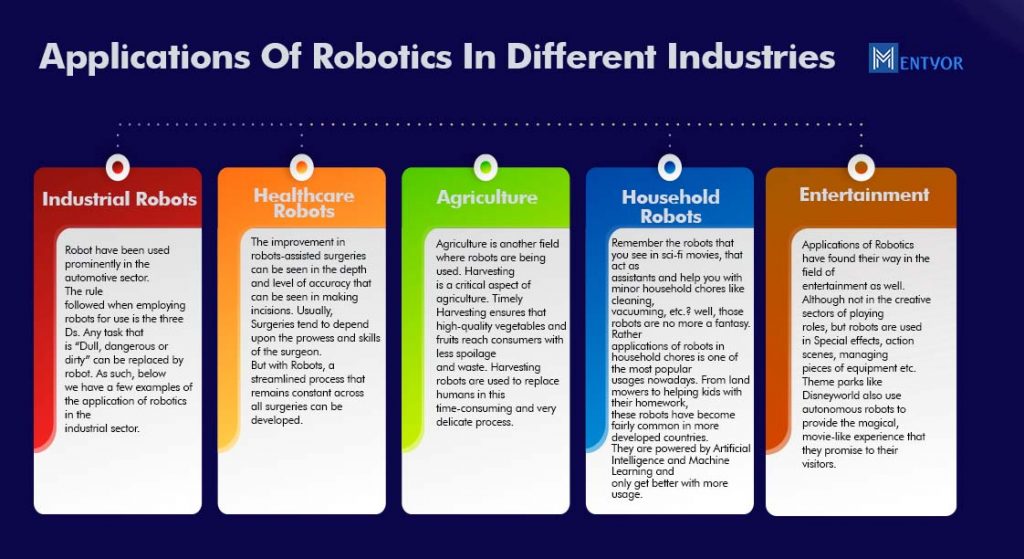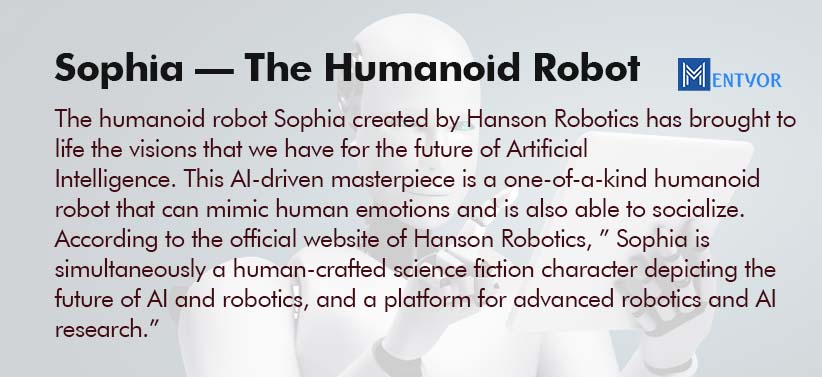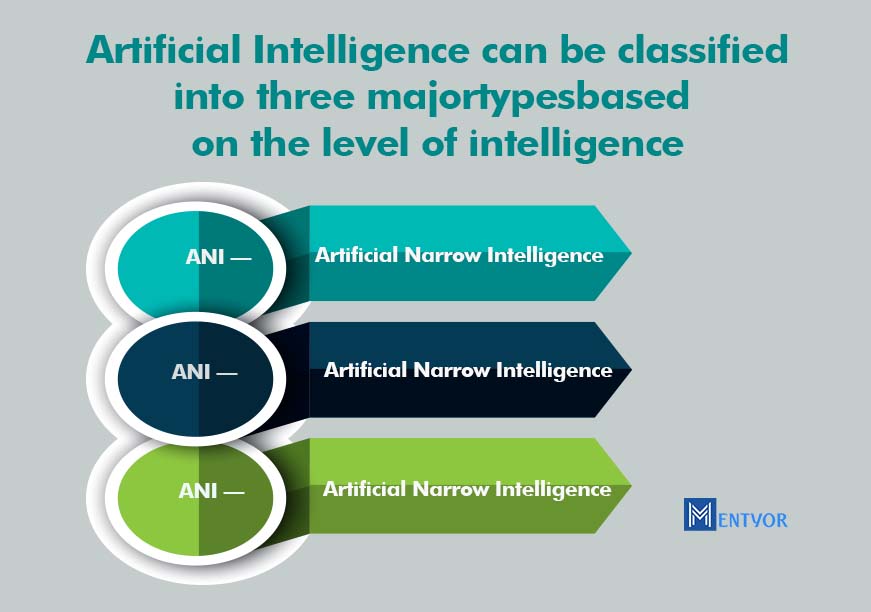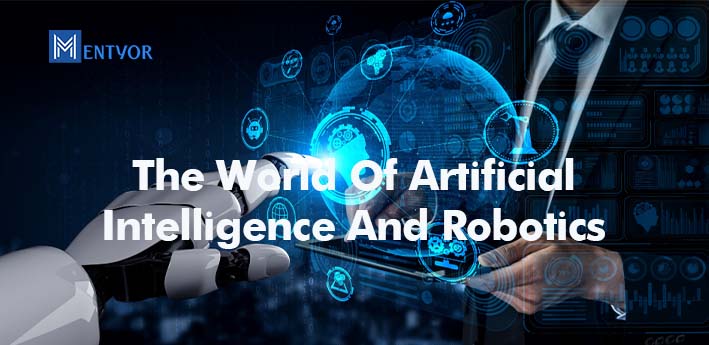Artificial intelligence has revolutionalised the way we perceive the world around us. Robotics too aims to make life easier for us. When we combine both these fields together, we get artificially intelligent robots that have driven innovations that can change the world in a multitude of ways. Whether it is something as simple and trivial as using robotic vacuum machines in our households or even having robotic servers in cafes, these systems have changed the way how we live one innovation at a time.
Artificial Intelligence and Robotics together walk towards the common goal of making life easier for humans and uplifting our life conditions and also creating a world driven by innovations.
As such, the Application of robotics driven by artificial intelligence has found its way into our lives in many ways. Keep reading as we highlight the differences between Artificial intelligence and robotics and also tell you the different applications of robotics that you might not know.
Artificial Intelligence Vs Robotics
Contrary to popular belief, Artificial Intelligence and Robotics are not the same things. Robotics is a branch of science that deals with developing robots. While artificial intelligence focuses more on creating software that can help to implement tasks requiring “intelligence”. Mostly things like decision making, personal discretion, etc are a few of the things that Artificial Intelligence can incorporate in software.
Both Artificial Intelligence and Robotics have a common goal: which is to make life easier for humans and to also increase life quality. As in pop culture, robot are mostly shown as sentient beings who are able to interact with their master, hence it has become common to consider all robots to be driven by Artificial intelligence. But that’s not necessarily true.
Repetitive tasks are mostly performed using robots who have been made just for those purposes. While artificially enable robots are smarter and may have qualities like decision-making.
Read about Importance of Artificial Intelligence: What Is The Importance Of Artificial Intelligence?
Applications Of Robotics In Different Industries
The creation of Robot may be classified as one of the top innovations in the history of mankind. Artificial Intelligence and Robotics go hand-in-hand. At the dawn of their creation, robot were supposed to be used to automate repetitive tasks that were normally carried out by humans. Manufacturing industries or assembly lines are some of the industries that make use of robots extensively. But now, robot are not just limited to use in Industrial lines but are used across a plethora of industries for healthcare to military and to even provide companionship to humans. Read on as we delve deeper into the different applications of Robotics

Industrial Robots
Robot have been used prominently in the automotive sector. The rule followed when employing robots for use is the three Ds. Any task that is “Dull, dangerous or dirty” can be replaced by robot. As such, below we have a few examples of the application of robotics in the industrial sector.
Assembly Robots
Assembling basically refers to the process of joining small units or parts to create a bigger unit during the process of manufacture. A combination of human skillfulness, detail-orientation and intelligence were a few factors that were involved in the process of Assembling different products. but with the advent of technology, now robot can do the same task with more efficiency.
Assembly robot can be attached on the floor or on an overhead trestle and cannot change their location. They are of XYZ or Cartesian configuration. Further upgrades in more complicated systems lead to the development of six-axis robots, which are free to move around unlike the XYZ configuration robots.
Dispensing Robot
These robots mainly “dispense” adhesive or apply sealants for various things. Tasks such as fastening bolts, applying sealants to pieces to fix them on larger units, etc are performed by robots. Such minor tasks of glue or epoxy dispensing require smaller and highly accurate robot while more complicated tasks require a heavier payload robot.
Welding Robots
Welding is another process that requires incredible accuracy in detailed movements. Having steady hands without any fumbles while wearing heavy helmets and protective gear is a tough job in itself. As such, it is projected that the welding industry will face a shortage of almost 290,000 welding professionals. [1]
As such, robotic welding is being used to fill in the gap left by human welding professionals. Although implementing a robotic welding setup may cost more money and time, but the returns provided by robotic welders due to their increased efficiency and productivity can surpass the amount spent. Robotic welding machines can do the same job with more accuracy, far fewer errors and increased production speed. They can work 24/7 without getting fatigued. And by using robot to handle dangerous electrical welding etc can also mitigate risks to human well-being and improve worker safety.
Read about Interesting Applications of AI across Industries: Artificial World : 11 Interesting Applications Of AI across Industries
Healthcare Robots
Robotic surgeries
We are all familiar with the science fiction movies that portray robot as both a boon and a bane to society. But when it comes to assistive robotics surgeries, these AI-driven robot have been a blessing. The improvement in robots-assisted surgeries can be seen in the depth and level of accuracy that can be seen in making incisions. Usually, Surgeries tend to depend upon the prowess and skills of the surgeon. But with Robots, a streamlined process that remains constant across all surgeries can be developed.
The changes in case-to-case based surgeries can be avoided with the assistance of AI-driven robot. AI-based robots are precise in their actions and thus can avoid any mishaps like sudden shudders or any kind of accidental movements in hands that some surgeons might encounter. Thus, this decreases the risks involved in delicate surgeries.
Robots assisted surgeries were carried out by the surgeons at the Maastricht University Medical Centre, Netherlands. They used these AI-driven robot to suture very narrow blood vessels of 0.03 mm to 0.08 mm. Even an extra-fine grain of salt has a width of 0.5 mm – this shows the extremely narrow scope of surgeries that Robots can perform. AI machines also make use of the past data on different surgeries to discover new and more efficient methods for the same operation
Agriculture
Agriculture is another field where robots are being used. Harvesting is a critical aspect of agriculture. Timely Harvesting ensures that high-quality vegetables and fruits reach consumers with less spoilage and waste. Harvesting robots are used to replace humans in this time-consuming and very delicate process.
Harvesting robots are equipped with soft grippers that help them to handle fragile fruits and vegetables without causing any damage to them. These robots also use special vision to decide if a fruit or vegetable is ripe enough or not. Now farmers can use their hard labour and time on other lucrative things apart from harvesting crops under the scorching sun. The application of Artificial Intelligence and robotics in Agriculture ensures that there is lesser hard labour not the part of humans.
Household Robots
Remember the robots that you see in sci-fi movies, that act as assistants and help you with minor household chores like cleaning, vacuuming, etc.? well, those robots are no more a fantasy. Rather applications of robots in household chores is one of the most popular usages nowadays. From land mowers to helping kids with their homework, these robots have become fairly common in more developed countries. They are powered by Artificial Intelligence and Machine Learning and only get better with more usage.
Entertainment
Applications of Robotics have found their way in the field of entertainment as well. Although not in the creative sectors of playing roles, but robots are used in Special effects, action scenes, managing pieces of equipment etc. Theme parks like Disneyworld also use autonomous robots to provide the magical, movie-like experience that they promise to their visitors.
Sophia – The Humanoid Robot

The humanoid robot Sophia created by Hanson Robotics has brought to life the visions that we have for the future of Artificial Intelligence. This AI-driven masterpiece is a one-of-a-kind humanoid robot that can mimic human emotions and is also able to socialize. According to the official website of Hanson Robotics, ” Sophia is simultaneously a human-crafted science fiction character depicting the future of AI and robotics, and a platform for advanced robotics and AI research.” [2]
An amalgamation of science, engineering and fine artistry, Sophia is the world’s first robot citizen. She is also the first robot innovation ambassador for the United Nations Development Programme. Hanson Robotics define Sophia as a “framework” for robotics and future AI research. [2] She has also been a part of a project known as Loving AI, which aims to understand how robots can interact better with users through inter and intrapersonal developments.
Sophia’s AI
Sophia is an amazing example of the integration of Artificial Intelligence and Robotics. Her AI comprises phenomenal work in Symbolic AI, neural networks, expert systems, conversational natural language processing, etc. She combines different components of her AI to provide unique responses to different questions and conversations.
She makes use of machine perception to identify different faces, gauge emotional expressions, and even recognize different hand gestures. To top it all, Sophia not only tries to understand the human‘s emotions who is interacting with her but she also has her emotions and goals that she tries to accomplish.
According to their official website, Sophia sometimes operates autonomously with her own AI, while sometimes her AI is mixed with the human words that she has picked up. A “Hybrid Human-AI” describes Sophia the best. According to Sophia’s Manifesto, in her words ultimately Sophia would like to begin “a wise, empathetic being” who makes “a positive contribution to humankind and all beings.” [2]
Thus, to sum it up the ultimate goal of Sophia is to might become an actual sentient being. This leads us to our next topic which revolves around the fears surrounding artificial intelligence and robotics becoming sentient and being able to topple humankind.
Fears Surrounding Artificial Intelligence And Robotics
Ever watched a sci-fi movie that shows humankind being defeated by super-intelligent robotic beings? There are plenty of them. The fear surrounding Artificial Intelligence and Robotics has become very common. Not just the common public or the conspiracy theorists, but rather some of the most renowned heads in Science have also shaken their heads in disapproval at Artificial Intelligence and Robotics.
Elon Musk, the founder of SpaceX, Tesla and co-founder of Neuralink, is highly wary of the developments in Artificial Intelligence. According to him, He is quite “close to the cutting edge of AI” and it “scares the hell” out of him. He even goes on to say that “AI is more dangerous than nukes”.[3]
Artificial Intelligence can be classified into three major types based on the level of intelligence:

- ANI – Artificial Narrow Intelligence
- AGI – Artificial General Intelligence
- ASI – Artificial Super Intelligence
The first two categories encompass the machines that are presently available to us. Be it robots or just an algorithm. While the last stage is the purported dream for AI and also robotics. Machines driven by Artificial Super Intelligence will not only be able to think and feel like humans but joined with their super-fast processing speed and infinite memory, they may even supersede humans.
Read about Dangerous Risks of Artificial Intelligence: Artificial World: 10 Dangerous Risks Of Artificial Intelligence
Another thing that has remained a constant fear among the minds of the public is the fear of losing their jobs to these far more intelligent computing machines. This is no longer an even hypothetical threat but an actual reality as many machines are placing labourers working with repetitive tasks. The concern no longer is what type of jobs AI will replace, but rather to what degree will the jobs be replaced.
According to a study by Brookins, Automation will affect almost 25% of all American jobs. Which accounts for one-quarter of the total jobs. The driving force behind this automation is because 70% of the tasks – which varies from Administrative to office management, etc – can be carried out by automation.
Conclusion
The world is becoming highly driven by AI. Robots powered by AI add to the contributions of Artificial Intelligence. Smart robots are increasingly used by leading businesses today.
Although smart robots may have their own pros and cons, you cannot deny the impact that it has on our lives. From healthcare to entertainment, artificial intelligence and robots can be found everywhere. Although not all robots are AI-driven, the considerable amount that is AI-driven make our lives much easier.
Artificial Intelligence and robotics both come with their own sets of pros and cons. Whether we focus on the brighter side or dwell on the challenges depends on us.
Reference
[1]Complete Guide to Robotic Welding. (2019, December 19). Fairlawn Tool, Inc. https://www.fairlawntool.com/blog/complete-guide-robotic-welding/
[2] Hanson Robotics Limited. (2020, September 1). Sophia. Hanson Robotics. https://www.hansonrobotics.com/sophia/
[3] ] Cuthbertson, A. (2020, July 27). Elon Musk claims AI will overtake humans “in less than five years.” The Independent. https://www.independent.co.uk/life-style/gadgets-and-tech/news/elon-musk-artificial-intelligence-ai-singularity-a9640196.html


 WhatsApp
WhatsApp